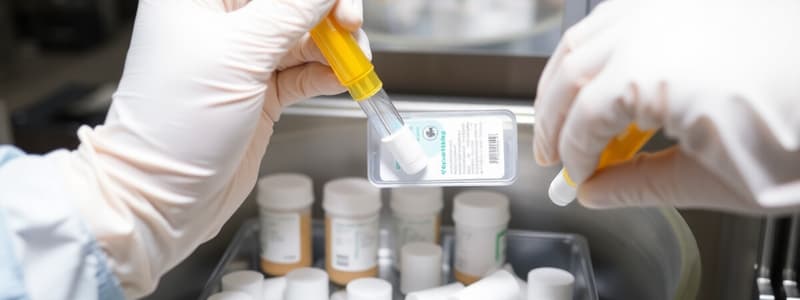Podcast
Questions and Answers
What is the definition of a viable microorganism?
What is the definition of a viable microorganism?
A viable microorganism is one that can form progeny, meaning it can reproduce and create new organisms.
What is sterilization in the context of pharmaceuticals?
What is sterilization in the context of pharmaceuticals?
Sterilization is the process of removing or destroying all viable microorganisms. It ensures that a product is free from contamination.
How do we know if a product is sterile? Briefly explain the difficulty in proving sterility.
How do we know if a product is sterile? Briefly explain the difficulty in proving sterility.
It is difficult to definitively prove a product is sterile. Sampling and culturing can potentially introduce contamination during the process, making it challenging to guarantee complete sterility.
What are the three primary sterilisation methods listed in the pharmacopoeia?
What are the three primary sterilisation methods listed in the pharmacopoeia?
What is the significance of the statement that 'modifications to, or combinations of these methods may be used provided there is sufficient process validation and product suitability'?
What is the significance of the statement that 'modifications to, or combinations of these methods may be used provided there is sufficient process validation and product suitability'?
What is aseptic processing in pharmaceutical manufacturing?
What is aseptic processing in pharmaceutical manufacturing?
Why is it crucial to consider both the product type and the chosen sterilisation method?
Why is it crucial to consider both the product type and the chosen sterilisation method?
What is the primary purpose of the pharmacopoeia in the context of sterilisation methods?
What is the primary purpose of the pharmacopoeia in the context of sterilisation methods?
What is the relationship between the death rate constant (k) and the decimal reduction time (D)?
What is the relationship between the death rate constant (k) and the decimal reduction time (D)?
Why is it important to specify the temperature when defining the D-value?
Why is it important to specify the temperature when defining the D-value?
Explain the concept of the Z-value and its significance in sterilization kinetics.
Explain the concept of the Z-value and its significance in sterilization kinetics.
What is the relationship between the Z-value and the D-value?
What is the relationship between the Z-value and the D-value?
What does a plot of log natural % survivors vs. time illustrate?
What does a plot of log natural % survivors vs. time illustrate?
How is the decimal reduction time (D) related to log cycles of microbial reduction?
How is the decimal reduction time (D) related to log cycles of microbial reduction?
What is the difference between sterilization and disinfection? How does this impact the concept of D-value?
What is the difference between sterilization and disinfection? How does this impact the concept of D-value?
Why is it significant to study sterilization kinetics?
Why is it significant to study sterilization kinetics?
What is the primary goal of sterile processing in pharmaceutical manufacturing?
What is the primary goal of sterile processing in pharmaceutical manufacturing?
Name three main types of sterilization methods used in pharmaceutical manufacturing.
Name three main types of sterilization methods used in pharmaceutical manufacturing.
What is the D-value in sterilization kinetics?
What is the D-value in sterilization kinetics?
In the context of sterilization, what does the F-value represent?
In the context of sterilization, what does the F-value represent?
What does SAL stand for, and why is it important?
What does SAL stand for, and why is it important?
What are the primary challenges associated with conducting sterility tests?
What are the primary challenges associated with conducting sterility tests?
Why is validation a critical part of the sterilization process?
Why is validation a critical part of the sterilization process?
What is the function of a biological indicator in a sterilization cycle?
What is the function of a biological indicator in a sterilization cycle?
What is the purpose of media fill studies in aseptic processing?
What is the purpose of media fill studies in aseptic processing?
In cleanroom design, what is the significance of airflow patterns?
In cleanroom design, what is the significance of airflow patterns?
What is the definition of sterility in the context of pharmaceutical products?
What is the definition of sterility in the context of pharmaceutical products?
Why are injectable products required to be sterile?
Why are injectable products required to be sterile?
Besides injectables, what other type of pharmaceutical product must be sterile?
Besides injectables, what other type of pharmaceutical product must be sterile?
What is a 'terminally sterilized' product?
What is a 'terminally sterilized' product?
Why are products produced using aseptic processing considered high-risk?
Why are products produced using aseptic processing considered high-risk?
What are two potential consequences of administering a non-sterile pharmaceutical product to a patient?
What are two potential consequences of administering a non-sterile pharmaceutical product to a patient?
Besides patient safety, what is another reason to ensure sterility of a pharmaceutical product?
Besides patient safety, what is another reason to ensure sterility of a pharmaceutical product?
Give an example of a product that is not always required to be sterile, but should be for certain uses.
Give an example of a product that is not always required to be sterile, but should be for certain uses.
What is the role of a sterilising filter in the manufacturing process?
What is the role of a sterilising filter in the manufacturing process?
Describe the nature of microbial death during thermal sterilisation.
Describe the nature of microbial death during thermal sterilisation.
How does moist heat sterilisation differ in microbial death kinetics compared to gas sterilisation?
How does moist heat sterilisation differ in microbial death kinetics compared to gas sterilisation?
What does a linear graph of log 10 percent survivors versus time indicate in sterilisation kinetics?
What does a linear graph of log 10 percent survivors versus time indicate in sterilisation kinetics?
In gas sterilisation, what factors besides time affect sterilisation effectiveness?
In gas sterilisation, what factors besides time affect sterilisation effectiveness?
What is the key consideration in radiation sterilisation when evaluating effectiveness?
What is the key consideration in radiation sterilisation when evaluating effectiveness?
Why is it important for filtration sterilisation to be performed under aseptic conditions?
Why is it important for filtration sterilisation to be performed under aseptic conditions?
How does the death rate of microorganisms change with time during a sterilisation process?
How does the death rate of microorganisms change with time during a sterilisation process?
What is the primary function of an isolator in clean room operations?
What is the primary function of an isolator in clean room operations?
How does the airflow design in a clean room help in maintaining cleanliness?
How does the airflow design in a clean room help in maintaining cleanliness?
What tests are necessary to ensure the integrity of an isolator?
What tests are necessary to ensure the integrity of an isolator?
Why is personnel considered a significant source of contamination in a clean room?
Why is personnel considered a significant source of contamination in a clean room?
What role do HEPA filters play in the clean room environment?
What role do HEPA filters play in the clean room environment?
What is the importance of positive or negative pressure in an isolator?
What is the importance of positive or negative pressure in an isolator?
How can the grade of the clean room differ for isolators compared to laminar airflow cabinets?
How can the grade of the clean room differ for isolators compared to laminar airflow cabinets?
What happens to air pressure as one moves from a cleaner to a less clean room?
What happens to air pressure as one moves from a cleaner to a less clean room?
Flashcards
Sterility
Sterility
The process of ensuring that products are free from living microorganisms.
Sterilization
Sterilization
The process of eliminating all living microorganisms from a product or material.
Thermal Sterilization
Thermal Sterilization
The use of heat to eliminate microorganisms from a product.
Radiation Sterilization
Radiation Sterilization
Signup and view all the flashcards
Gas Sterilization
Gas Sterilization
Signup and view all the flashcards
Filtration Sterilization
Filtration Sterilization
Signup and view all the flashcards
Sterilization Kinetics
Sterilization Kinetics
Signup and view all the flashcards
Sterility Assurance Level (SAL)
Sterility Assurance Level (SAL)
Signup and view all the flashcards
Sterility Test
Sterility Test
Signup and view all the flashcards
Sterilization Validation
Sterilization Validation
Signup and view all the flashcards
Parenteral Products
Parenteral Products
Signup and view all the flashcards
Ophthalmic Products
Ophthalmic Products
Signup and view all the flashcards
Terminal Sterilization
Terminal Sterilization
Signup and view all the flashcards
Aseptic Processing
Aseptic Processing
Signup and view all the flashcards
Absence of Viable Microorganisms
Absence of Viable Microorganisms
Signup and view all the flashcards
European Pharmacopoeia
European Pharmacopoeia
Signup and view all the flashcards
Viable Microorganism
Viable Microorganism
Signup and view all the flashcards
Spore
Spore
Signup and view all the flashcards
Culturing
Culturing
Signup and view all the flashcards
Steam Sterilization
Steam Sterilization
Signup and view all the flashcards
Dry Heat Sterilization
Dry Heat Sterilization
Signup and view all the flashcards
Ionizing Radiation Sterilization
Ionizing Radiation Sterilization
Signup and view all the flashcards
D-value
D-value
Signup and view all the flashcards
Death rate constant (k)
Death rate constant (k)
Signup and view all the flashcards
Z-value
Z-value
Signup and view all the flashcards
Microbial survival curve
Microbial survival curve
Signup and view all the flashcards
Sterilization kinetics parameters
Sterilization kinetics parameters
Signup and view all the flashcards
Sterilizing Filter
Sterilizing Filter
Signup and view all the flashcards
Exponential Microbial Death
Exponential Microbial Death
Signup and view all the flashcards
Gas Sterilization Kinetics
Gas Sterilization Kinetics
Signup and view all the flashcards
Radiation Sterilization Kinetics
Radiation Sterilization Kinetics
Signup and view all the flashcards
Filtration Sterilization Kinetics
Filtration Sterilization Kinetics
Signup and view all the flashcards
Isolator
Isolator
Signup and view all the flashcards
Laminar Airflow Cabinet
Laminar Airflow Cabinet
Signup and view all the flashcards
Transfer Hatch
Transfer Hatch
Signup and view all the flashcards
Pressure Differentials
Pressure Differentials
Signup and view all the flashcards
HEPA Filter
HEPA Filter
Signup and view all the flashcards
Uni-directional Airflow
Uni-directional Airflow
Signup and view all the flashcards
Non-uni-directional Airflow
Non-uni-directional Airflow
Signup and view all the flashcards
Personnel in Clean Rooms
Personnel in Clean Rooms
Signup and view all the flashcards
Study Notes
Sterile Processing and Manufacturing of Sterile Products
- Introduction to the requirement for sterility in various products
- Defining sterility and sterilization
- Sterilization methods used in pharmaceutical manufacturing: thermal, radiation, gas, filtration
- Sterilization kinetics and parameters (K, D, Z, and F)
- K-value: The Death Rate Constant
- D-value: Decimal Reduction Time
- Z-value graph
- F-value
- Sterilization kinetics and sterility assurance level (SAL)
- Sterility test and associated problems; false positives, false negatives, low levels of contamination, undetected contamination
- Validation
- Monitoring and validation: Biological and Physical indicators
- Aseptic processing: cleanrooms, cleanroom design, operations, airflow, personnel, general cleanroom design and processes,
- Production of sterile products; media fill studies, some other relevant tests; sterility tests, pyrogen or bacterial endotoxin testing, particulate contamination testing.
- Summary of the key points and topics covered
Studying That Suits You
Use AI to generate personalized quizzes and flashcards to suit your learning preferences.




